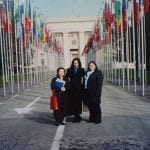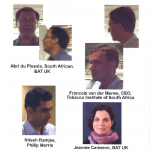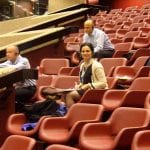After the party

Jeannie Cameron is managing director of JCIC International
How the Conference of Parties has affected the tobacco industry—and what to expect going forward.
By Jeannie Cameron

COP stands for Conference of the Parties. In the tobacco context it is a meeting of the parties to the Framework Convention on Tobacco Control (FCTC) treaty of 2005. There are also COPs associated with the Framework Convention on Climate Change and its Protocols. The parties are representatives of the governments that have given consent to be bound to the provisions of the treaty through an act of ratification or accession. At the time of writing there were 180 parties to the FCTC.
At each COP, members discuss elements of FCTC implementation, including checking off national actions, hearing the feedback of intersessional working groups and deciding future plans. COP decisions are made by consensus—an absence of a formal objection. So while technically the COP can vote, it is not the norm.
It therefore has a major role in strategic planning and oversight: to promote and facilitate the exchange of information, as well as to promote and guide the development of research and collection of data. One of its most significant roles is to act as a coordinator and repository for the collection of national reports of FCTC implementation; reports that must be submitted at regular intervals as an FCTC legal obligation.
The COP can adopt protocols, or sub-treaties, as it has done with the Illicit Trade Protocol, and make amendments to the FCTC. It also has the power to establish the criteria for the participation of observers at its proceedings—it can decide, for example, whether to open or close the viewing gallery to the public, including the tobacco industry. The COP has its own permanent secretariat to provide for functioning and to manage its budget.
Governments are allowed to put anyone they choose on a COP delegation. Nongovernment participants are known generally as advisors. COP observers are accredited from either from a state that has signed but not ratified the treaty, such as the United States, or from a state that has neither signed nor acceded to the FCTC, despite having taken part in the negotiations, such as Cuba.
COP observers also include accredited NGOs and most intergovernmental organizations. Nonaccredited NGOs, the tobacco industry and all other members of the public are only permitted to watch proceedings from a public gallery—a right related to proper international governance, which has been eroded in recent COPs.
A team of advisors, known as “the Bureau” heads the COP Secretariat, and it includes one advisor from each of the WHO regions. The Bureau’s president, five vice presidents and six regional coordinators are elected at the conclusion of each COP and finish their term at the conclusion of the next.
At COP, all the excitement takes place in Committee A, the body that discusses and adopts the FCTC guidelines. In terms of impact on the tobacco industry, Committee A is the one to watch.
While it is true that the guidelines are not legally binding—a point that tobacco industry legal departments have always been keen to point out—the FCTC is a political beast and governments will interpret as they wish or are encouraged to do so, as we have seen with plain packaging. Plain packaging does not feature in the legally binding FCTC treaty because in 2000–2003 the majority of the 193 government FCTC negotiators did not want it. Indeed, even graphic health warnings were excluded; the treaty included only pictorial health warnings as something to be considered if it were thought appropriate to do so. This shows clearly how the politics of a COP, the elaboration of guidelines and the subsequent political pressure, brought about policy outcomes the tobacco industry, in its determination to believe only in a legal interpretation, did not expect.
COP 1 – Geneva 2006
The six WHO regions take turns to host the COP. The first COP took place in Geneva, Feb. 6–17, 2006, shortly after the FCTC entered into force. At that point there were 113 COP members. During the meeting participants agreed upon financial and procedural rules (which were amended at COP6 in 2014). These rules would ultimately impact the industry because they gave the organization the power to close its public gallery, excluding the public and the tobacco industry from observing the debates in July 2009.
COP1 got the ball rolling with guidelines for FCTC implementation, and it agreed to initiate the elaboration of guidelines on the substantive issues of Articles 8 (protection from exposure to tobacco smoke) and Article 9 (regulation of the contents of tobacco products). It established working groups to discuss these issues and report back to COP2.
COP1 also established the reporting system and discussed the possibility of future FCTC protocols on cross-border advertising, promotion and sponsorship and on illicit trade in tobacco products.
COP2 – Bangkok 2007
COP2 took place in Bangkok, Thailand, June 30–July 6, 2007. At this time, there were 146 parties. From a personal perspective, this meeting is my favorite meeting to date. I think it was the logistical challenge of getting to the conference center through Bangkok’s notorious rush hour traffic that brought about the idea of traveling over the water instead.
Each morning we would rent a suitable long boat on the banks of the Chao Praya River. The risk takers among us tobacco-industry representatives would pile in, negotiate the waves and river traffic, and continue the journey to the conference center in tuk-tuks at the other end.
COP2 went on to adopt guidelines on Article 8 (the protection from exposure to tobacco smoke) and initiated work on further areas: Article 5.3 (tobacco industry participation); Article 11 (packaging and labeling) and Article 13 (advertising and sponsorship). It also began the process for recommendations for Articles 17 and 18 (economically sustainable alternatives to tobacco growing). In addition, COP2 agreed to establish an Intergovernmental Negotiating Body (INB) on a Protocol on Illicit Trade in Tobacco Products.
I distinctly recall Ian Walton George of the European Anti-Fraud Office (OLAF) arguing that Article 5.3 would not be relevant to the issue of illicit trade as it was not technically a health policy. He also said that, on such an important issue, it was imperative to consult with the tobacco industry.
I also recall it being the first COP where anti-smoking activists chased us around with cameras, attempting to snap anyone from the industry talking to a government delegate. Alas, that did not happen, and so pictures emerged in the NGO daily news bulletins with captions that stretched the imagination. One appeared showing a picture of me sitting taking notes in the public gallery with the caption that I was looking for marketing opportunities to undermine the discussions on product regulation.
The public smoking guidelines adopted at COP2 contributed to the stigmatization of smoking and its prohibition in many indoor and even outdoor public places. It also resulted in a significant stiffening of penalties for lighting up in smoke-free areas. These same policies are now impacting e-cigarette users, as well—even though vapor is not the same as tobacco smoke.
Despite COP2’s clear signals, including references to plain packaging, the tobacco industry at the time underestimated the risk.
COP 3 – Durban 2008
COP3 was held in Durban, South Africa, Nov. 17–22, 2008. With more than 600 delegates, it remains one of the largest COPs to date. It was also the first COP where access to the public gallery began to be restricted, with the WHO issuing only 30 passes per day, ostensibly for security reasons.
We had to get up earlier every day to get a pass, and we had to line up in an underground car park. Not many would believe that we did that—but we did so, quietly and orderly. One potential public applicant fell to his knees in desperation when advised he was number 31. The next day, he was there before 6 a.m. to ensure he’d be among the first 30 when passes were issued at 10 a.m.
As expected, the intersessional working groups on Article 5.3 (industry participation), Article 11 (packaging and labeling) Article 13 (advertising and sponsorship) delivered their guideline recommendations and the COP unanimously adopted each.
Even though some countries raised concerns, the guidelines on plain packaging were adopted by consensus. For example, my COP3 notebook reminds me that China asked the COP to delete 50 percent of the Article 11 guidelines. It also asked how plain packaging could be a recommendation of best practice when no country in the world had yet done it?
The Chair stated that the aim of the guidelines is not to enlarge or extend obligations—it was only to assist in implementation—and then after a few voices of support for no change to the draft, that was it; the guidelines were adopted. The same was true of the Article 13 guidelines regarding domestic enforcement of complete advertising ban, apart from where constitutional issues were found, and that was that—adopted. The working group on 5.3 guidelines, regarding participation of the tobacco industry, presented the draft and some objections began to be raised by the COP. According to my notebook, China argued that anyone interested should be entitled to raise anything. Once again the Chair intervened. “China is right,” he said, “however, we have a timing issue.”
The COP process is completely different to an INB process in so far as following due process is concerned. At an INB, any government representative taking the floor to speak on behalf of the government must have full powers to do so from either the head of state or the minister for foreign affairs, because in that capacity a representative has the power to legally bind a state to what is being negotiated.
This is how the FCTC and the protocol were negotiated. At COP, by contrast, anyone can speak for anyone, and this was witnessed often. On one occasion I saw a New Zealand NGO speaking for Saudi Arabia before taking another seat to speak for another country.
COP3 has had a most significant impact on the tobacco industry—one that has not yet fully played out as governments, fueled by political pressure, continue to implement the FCTC.
In the typical pattern, in the final hour of the COP, more guidelines were brought on for elaboration. My COP3 notebook reminds me that at the end of COP3, the Philippines raised that the WHO should seek expert advice to elaborate Article 6 (price and tax). One by one the WHO regions supported the Philippines and eventually the European region, represented by France, took the floor, proposing that the EU would draft the resolution on behalf of the COP. Those present could see that France was motivated by the need to reign back in what was fast becoming a rather concerning proposal on tax, and therein the EU became part of the consensus.
COP3 was also where the notorious “Merchants of Death” poster was circulated. Headed “Beware the Merchants of Death,” the poster carried a picture of me and three colleagues. It was funny on one level, and some delegates even asked for it to be autographed, but it was scary on another level, as the photo of me had been taken during winter and it being summer in the southern hemisphere meant the photo had been in someone’s file.
COP 4 – Punte del Este 2010
After COP3, COPs were to take place every two years rather than yearly and so COP4 was held Nov. 15-20, 2010, in Punta del Este, Uruguay. With 137 parties participating, COP4 adopted new implementation guidelines for Article 12 (education, communication, training and public awareness) and Article 14 (demand reduction measures concerning tobacco dependence and cessation) and partial guidelines for Article 9 (regulation of the contents of tobacco products) and Article 10 (regulation of tobacco product disclosures).
COP4 established a working group to elaborate guidelines on Article 6 (price and tax policies) and to continue the work on economically sustainable alternatives to tobacco growing, as well as to continue negotiations on a protocol to combat illicit trade in tobacco products. COP4 set up an expert group on Article 13 (cross-border advertising, promotion and sponsorship) to keep the COP up to date and to monitor progress in this area of work. At this COP, tobacco growers conducted various lively demonstrations not seen for some while. The growers were intent on making sure the COP understood their specific issues and that their livelihoods were at stake.
Parties adopted the Punta del Este Declaration aimed at strengthening the implementation and protection of public health policies in relation to tobacco control. They also adopted decisions to engage more actively with international organizations and bodies in promoting treaty implementation. Special focus was placed on the integration of implementation of the WHO FCTC with the existing mechanisms for development cooperation and the “One UN” framework.
COP 5 – Seoul 2012
COP5 took place in Seoul, Republic of Korea, Nov. 12–17, 2012, and included 140 parties. “Gangnam Style,” the Korean top of the pops, was order of the day and consequently there were often impromptu performances around the conference center to entertain delegates—or at least those of us who had been voted out of the room when the public gallery closed. As was the case at COP3, we had to get there ever earlier to secure a pass—at least until the lockout occurred. On one occasion that meant arriving at the conference in the dark at 4 a.m. and using a phone torch (flashlight) to navigate to where the queue would begin.
COP5 adopted a set of guiding principles and recommendations to support the implementation of Article 6 on price and tax measures to reduce the demand for tobacco, and established a working group to finalize the full guidelines. COP5 amended the partial guidelines on Articles 9 and 10 relating to ingredients and product characteristics, and requested this working group to continue its product related work.
COP5 also began to consider areas of harm reduction by opening up discussion of work in relation to smokeless tobacco and electronic nicotine-delivery systems. It also established an expert group on Article 19 (Liability). This working group is expected to report at COP7, scheduled for later this year in Delhi, India.
COP5 established a process for further developing policy options and recommendations on economically sustainable alternatives to tobacco growing. Most significantly, it adopted the FCTC’s first Protocol: the Protocol to Eliminate Illicit Trade in Tobacco Products. The COP5 parties also made a collective commitment in the Seoul Declaration, to accelerate implementation of the FCTC and to protect it from interference by the tobacco industry—a growing theme.
COP 6 – Moscow 2014
COP6 took place in Moscow, Russia, Oct 13–18, 2014, and was attended only by 135 parties despite there being nearly 170 parties at that point. COP6 finally adopted guidelines on price and tax and issued guidance on smokeless tobacco products, electronic nicotine-delivery systems, electronic nonnicotine-delivery systems, as well as water-pipe tobacco products. COP6 was also where trade and investment issues began to emerge in a significant way, fueled presumably by the various tobacco industry litigation cases taking place around the globe. There was a feeling at the end of COP6 that things had more or less been done, and the momentum of earlier COPs had dissipated. This feeling was fairly widespread and there many that expect therefore, COP7 to be bring about a renaissance.
COP 7 – New Delhi 2016
COP 7 will take place in New Delhi India Nov. 7–12, 2016. The first Meeting of the Parties (MOP) for the FCTC protocol is scheduled for Nov. 14–16. The MOP cannot take place until 40 FCTC parties have ratified the protocol, and at time of writing there are only 16 parties to the protocol. There are 54 signatories to date, so a rather large pool for political pressure to be placed upon. There may well be a flurry of ratifications by early August—the time by which a party must submit consent to be bound by the protocol in order for the MOP to take place as scheduled.
COP7 is expected to focus further on product characteristics, liability, sustainable development, trade and the areas of harm reduction, e-cigarettes, smokeless tobacco products and other nicotine-delivery systems.
It will be significant for the COP to determine whether it will be able to put public health ahead of politics and accept that tobacco may not harmful in all its forms—and that harm reduction is a policy that can apply to tobacco as well as other areas of public health. The FCTC already requires national tobacco control policy to include harm reduction strategies, and the COP has the capacity to embrace this concept, but it remains to be seen what will emerge. It will require a pragmatic approach.
U.S. government FCTC delegate Greg Jacob wrote in the Chicago Journal of International Law (2004) that the WHO FCTC process made him feel as though he had stepped into the Geneva edition of the Twilight Zone. He makes the point—one that has not changed—that rather than negotiating with foreign states, governments are negotiating with foreign health ministries that are not necessarily pursuing policies favored by their home governments. “Delegates saw the FCTC as an opportunity to do an end-run around their governments by inserting strong anti-tobacco measures into the convention and then relying on international political pressure to force their governments to join it. Some of the delegates openly admitted their ulterior agendas, making plaintive appeals from the floor to force the hand of their government back home.”



